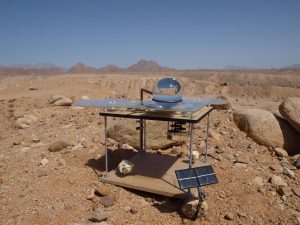 The Middle East and North Africa (MENA) are expected to bring 3.5GW of solar capacity online by 2015: Saudi Arabia and Turkey lead the way.
The Middle East and North Africa (MENA) are expected to bring 3.5GW of solar capacity online by 2015: Saudi Arabia and Turkey lead the way.
A new report published by Green Tech Media (GTM) Research pins the surge from today’s near-negligible production on rapidly rising energy demand spurred by MENA economic expansion, population growth, and urbanization. It helps that the region is supersaturated with sunlight.
Factor in rising opposition to nuclear development and growing public awareness of the environmental sins of fossil fuels, and solar’s sunny reception makes perfect sense. Plus renewables, specifically concentrated solar (CSP) and photovoltaics (PV), would provide a secure domestic substitute for state-subsidized oil-generated electricity.
Saudi Arabia and Turkey are expected to account for 70 percent of MENA’s total demand; each nation has unique motivations and strategies.
Conservation of oil for export is driving Saudi’s solar targets: 16GW of PV and 25GW of CSP by 2030. Turkey’s swing towards solar is a defense against its tenuous reliance on imported Russian and Iranian gas.
Saudi production will be based on large-scale ground-mounted arrays and CSP plants. Turkey will go with commercial and industrial rooftop PV segments.
In 2005, Turkey was the first MENA nation to establish a feed-in tariff (FIT), a limited program that failed to create adequate demand to attract large manufacturing. But with a retooled FIT in place and favorable renewable energy policies, Turkey’s predicted to experience significant PV demand. The nation has a 2023 solar target of 3GW, a planned capacity that GTM believes they’ll significantly exceed.
Abu Dhabi is moving forward with Shams-1, the world’s largest single-unit (100MW) concentrating solar power plant. Qatar plans to install 1.8 GW of PV capacity by 2014 and Dubai aims to source 5% of its power supply from solar by 2030. Then there’s Abu Dhabi’s EU-backed Desertec project.
Jordan and Morocco also have solar ambitions.
Last December, Jordan announced the kingdom’s first FIT. Energy Regulatory Commission (ERC) Commissioner Mohammad Hamid told pv-tech,“With rising international oil prices, the government has been looking for ways to reduce electricity demand and costs. We found that the best way to achieve both is by encouraging Jordanians to go solar.” ERC claims that solar could save individuals and small to medium sized businesses up to 70% on their monthly bills.
Intentionality is great, but implementation demands strong policies and reasonable regulatory frameworks. In a region experiencing dramatic political and social change, solar’s future remains dubious.
The report was authored GTM Research analyst Scott Burger in collaboration with the Emirates Solar Industry Association. Burger presented highlights at the World Future Energy Summit on January 16th, describing major stakeholders, overall market structure, and long term outlook of each solar market in the region.
The full report is available for purchase on the GTM website.
Top image via Shams Youtube Video




Solar energy is wonderful, but unless humanity can safely recycle 100% of its waste materials, and peacefully reduce its population with family planning education, there will be ecocide and we will go extinct.